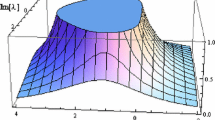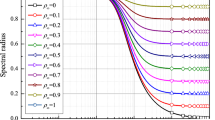Abstract
In this article, we investigate the convergence rate of the following dynamic system in \({\mathbb {R}}^{n}\)
where A denotes the constant positive definite matrix and the potential function \(F:{\mathbb {R}}^n\rightarrow {\mathbb {R}}\) is continuous differentiable. This system is of vital importance, especially in optimization and engineering. This article presents new convergence rates of the above dynamics when F(x) satisfies some local geometrical properties by constructing a proper Lyapunov function. Finally, some numerical experiments were performed to explain the convergence results.

Similar content being viewed by others
References
Alecsa, C.D.: The long time behavior and the rate of convergence of symplectic convex algorithms obtained via splitting discretizations of inertial damping systems (2020). arXiv:2001.10831
Alecsa, C.D., László, S.C., Viorel, A.: A gradient-type algorithm with backward inertial steps associated to a nonconvex minimization problem. Numer. Algorithms. 83, 485–512 (2019). https://doi.org/10.1007/s11075-019-00765-z
Alvarez, F.: On the minimizing property of a second order dissipative system in hilbert spaces. SIAM J. Control. Optim. 38(4), 1102–1119 (2000). https://doi.org/10.1137/s0363012998335802
Alvarez, F., Attouch, H., Bolte, J., Redont, P.: A second-order gradient-like dissipative dynamical system with hessian-driven damping. application to optimization and mechanics. Journal de mathématiques pures et appliquées. 81(8), 747–779 (2002). https://doi.org/10.1016/S0021-7824(01)01253-3
Antonin, C., Charles, D.: On the convergence of the iterates of the fast iterative shrinkage/thresholding algorithm. J. Optim. Theory Appl. 166(3), 968–982 (2015). https://doi.org/10.1007/s10957-015-0746-4
Attouch, H., Cabot, A.: Asymptotic stabilization of inertial gradient dynamics with time-dependent viscosity. J. Differential Equations 263(9), 5412–5458 (2017). https://doi.org/10.1016/j.jde.2017.06.024
Attouch, H., Chbani, Z., Fadili, J., Riahi, H.: First-order optimization algorithms via inertial systems with hessian driven damping. Math. Program. (2020). https://doi.org/10.1007/s10107-020-01591-1
Attouch, H., Chbani, Z., Peypouquet, J., Redont, P.: Fast convergence of inertial dynamics and algorithms with asymptotic vanishing viscosity. Math. Program. 168(1), 123–175 (2018). https://doi.org/10.1007/s10107-016-0992-8
Attouch, H., Goudou, X., Redont, P.: The heavy ball with friction method, I. the continuous dynamical system global exploration of the local minima of a real-valued function by asymptotic analysis of a dissipative dynamical system. Commun. Contemporary Math. 2(1), 1–43 (2000). https://doi.org/10.1142/S0219199700000025
Aujol, J.F., Dossal, C.: Optimal rate of convergence of an ode associated to the fast gradient descent schemes for \(b>0\) (2017). https://hal.inria.fr/hal-01547251
Aujol, J.F., Dossal, C., Rondepierre, A.: Optimal convergence rates for nesterov acceleration. SIAM J. Optim. 29(4), 3131–3153 (2019). https://doi.org/10.1137/18M1186757
Balti, M., May, R.: Asymptotic for the perturbed heavy ball system with vanishing damping term. Evol. Equ. Control Theory. 6(2), 177–186 (2017). https://doi.org/10.3934/eect.2017010
Cabot, A.: Asymptotics for a gradient system with memory term. Proc. Am. Math. Soc. 137(9), 3013–3024 (2009). https://doi.org/10.1090/s0002-9939-09-09910-9
Cabot, A., Engler, H., Gadat, S.: On the long time behavior of second order differential equations with asymptotically small dissipation. Trans. Am. Math. Soc. 361(11), 5983–6017 (2009). https://doi.org/10.1090/S0002-9947-09-04785-0
Chopra, A.K.: Dynamics of structures. Pearson Education India (2007)
Hale, J.K.: Asymptotic behavior of dissipative systems. 25. American Mathematical Society. (2010)
Haraux, A.: Systemes dynamiques dissipatifs et applications. Elsevier Masson, Amsterdam (1991)
Haraux, A., Jendoubi, M.A.: Convergence of solutions of second-order gradient-like systems with analytic nonlinearities. J. Differential Equ. (1998). https://doi.org/10.1006/jdeq.1997.3393
Haraux, A., Jendoubi, M.A.: Asymptotics for a second order differential equation with a linear, slowly time-decaying damping term. Evol. Equ. Control Theory. 2(3), 461–470 (2013). https://doi.org/10.3934/eect.2013.2.461
Jendoubi, M.A., May, R.: Asymptotics for a second-order differential equation with nonautonomous damping and an integrable source term. Appl. Anal. 94(2), 435–443 (2015). https://doi.org/10.1080/00036811.2014.903569
László, S.C.: Convergence rates for an inertial algorithm of gradient type associated to a smooth non-convex minimization. Math. Program. (2020). https://doi.org/10.1007/s10107-020-01534-w
László, S.C.: A forward-backward algorithm with different inertial terms for the minimization of the sum of two non-convex functions. (2020). arXiv:2002.07154
Li, Z., Xue, X.: Convergence of analytic gradient-type systems with periodicity and its applications in kuramoto models. Appl. Math. Lett. 90, 194–201 (2019). https://doi.org/10.1016/j.aml.2018.10.015
Love, J.S., Tait, M.J., Toopchi-Nezhad, H.: A hybrid structural control system using a tuned liquid damper to reduce the wind induced motion of a base isolated structure. Eng. Struct. 33(3), 738–746 (2011). https://doi.org/10.1016/j.engstruct.2010.11.027
Marano, G.C., Greco, R., Trentadue, F., Chiaia, B.: Constrained reliability-based optimization of linear tuned mass dampers for seismic control. Int. J. Solids Struct. 44(22–23), 7370–7388 (2007). https://doi.org/10.1016/j.ijsolstr.2007.04.012
May, R.: Asymptotic for a second-order evolution equation with convex potential and vanishing damping term. Turk. J. Math. 41(3), 681–685 (2017). https://doi.org/10.3906/mat-1512-28
Nesterov, Y.: A method of solving a convex programming problem with convergence rate \(o(1/k^2)\). Soviet Math. Program. 27(2), 372–376 (1983)
Parikh, N., Boyd, S.: Proximal algorithms. Found Trends Opt. 1(3), 127–239 (2014). https://doi.org/10.1561/2400000003
Polyak, B.T.: Some methods of speeding up the convergence of iteration methods. USSR Comput. Math. Math. Phys. 4(5), 1–17 (1964). https://doi.org/10.1016/0041-5553(64)90137-5
Polyak, B.T., Shcherbakov, P.S.: Optimisation and asymptotic stability. Int. J. Control 91(11), 2404–2410 (2018). https://doi.org/10.1080/00207179.2016.1257154
Sebbouh, O., Dossal, C., Rondepierre, A.: Convergence rates of damped inertial dynamics under geometric conditions and perturbations. SIAM J. Optim. 30(3), 1850–1877 (2020). https://doi.org/10.1137/19M1272767
Su, W., Boyd, S., Candes, E.J.: A differential equation for modeling nesterovs accelerated gradient method: Theory and insights. J. Mach. Learn. Res. 17(153), 1–43 (2016). https://doi.org/10.5555/2969033.2969107
Wen, B., Xue, X.: The long time behavior of a class of second-order gradient-like systems with vanishing dissipative term and non-convex analytic potential. Appl. Math. Lett. 43, 33–37 (2015). https://doi.org/10.1016/j.aml.2014.11.010
Xiang, P., Nishitani, A.: Optimum design for more effective tuned mass damper system and its application to base-isolated buildings. Struct. Control. Health Monit. 21(1), 98–114 (2014). https://doi.org/10.1002/stc.1556
Acknowledgements
This work is supported by the National Natural Science Foundation of China (No. 11201095), the Postdoctoral research startup foundation of Heilongjiang (No. LBH-Q14044), the Science Research Funds for Overseas Returned Chinese Scholars of Heilongjiang Province (No. LC201502)
Author information
Authors and Affiliations
Corresponding author
Additional information
Publisher's Note
Springer Nature remains neutral with regard to jurisdictional claims in published maps and institutional affiliations.
Appendix: Existence and uniqueness of the solution of (1)
Appendix: Existence and uniqueness of the solution of (1)
Theorem 4
For any initial value \((x_0\), \(v_0)\), there is a unique solution of system (1) defined on \([0,+\infty )\) satisfying \(x(0)=x_0\), \({\dot{x}}(0)=v_0\), if F(x) is bounded from below.
Proof
Let \(X(t)=(x(t),{\dot{x}}(t))^T\), \(X(0)=(x_0, v_0)^T\), \(G(u,v)=(v,-\frac{Av}{t}-\nabla F(u))^T\). So the system is equivalent to the following system:
Because of the Lipschitz continuity of \(\nabla F\) on a bounded subset of \({\mathbb {R}}^n\), it is easy to obtain the uniqueness and existence of a local solution associated with the system (31), it is also ture for system (1).
Assume that the maximum existence interval of the solution of (1) is \([t_0,T_{\max } )\), where \(0<T_{\max }\le +\infty \). Let \(W:[t_{0},+\infty )\rightarrow {\mathbb {R}}\) be defined by
For each \(t\ge t_{0}\),
So W(t) is nonincreasing, we can get:
Since the function F is bounded from below,
So \({\dot{x}}(t)\in L^{\infty }([t_0,T_{\max }); {\mathbb {R}}^n)\), assume \(T_{\max }<+\infty \),
Note that \(T_{\max }<+\infty \), hence \(x(t)\in L^{\infty }([0,T_{\max });{\mathbb {R}}^n)\) and \(x_\infty :=\lim \limits _{t\rightarrow T_{\max }}x(t)\) exists in \({\mathbb {R}}^n\). Similarly, we define \({\dot{x}}_\infty :=\lim \limits _{t\rightarrow T_{\max }}{\dot{x}}(t)\), now we take \((x_\infty ,{\dot{x}}_\infty )\) as the initial value for the system, so the solution can be extended to a larger intervals, this is impossible. Henece, \(T_{\max }=+\infty \). \(\square \)
Rights and permissions
About this article
Cite this article
Ge, B., Zhuge, X. & Ren, H. Convergence rates of damped inerial dynamics from multi-degree-of-freedom system. Optim Lett 16, 2753–2774 (2022). https://doi.org/10.1007/s11590-022-01855-z
Received:
Accepted:
Published:
Issue Date:
DOI: https://doi.org/10.1007/s11590-022-01855-z




